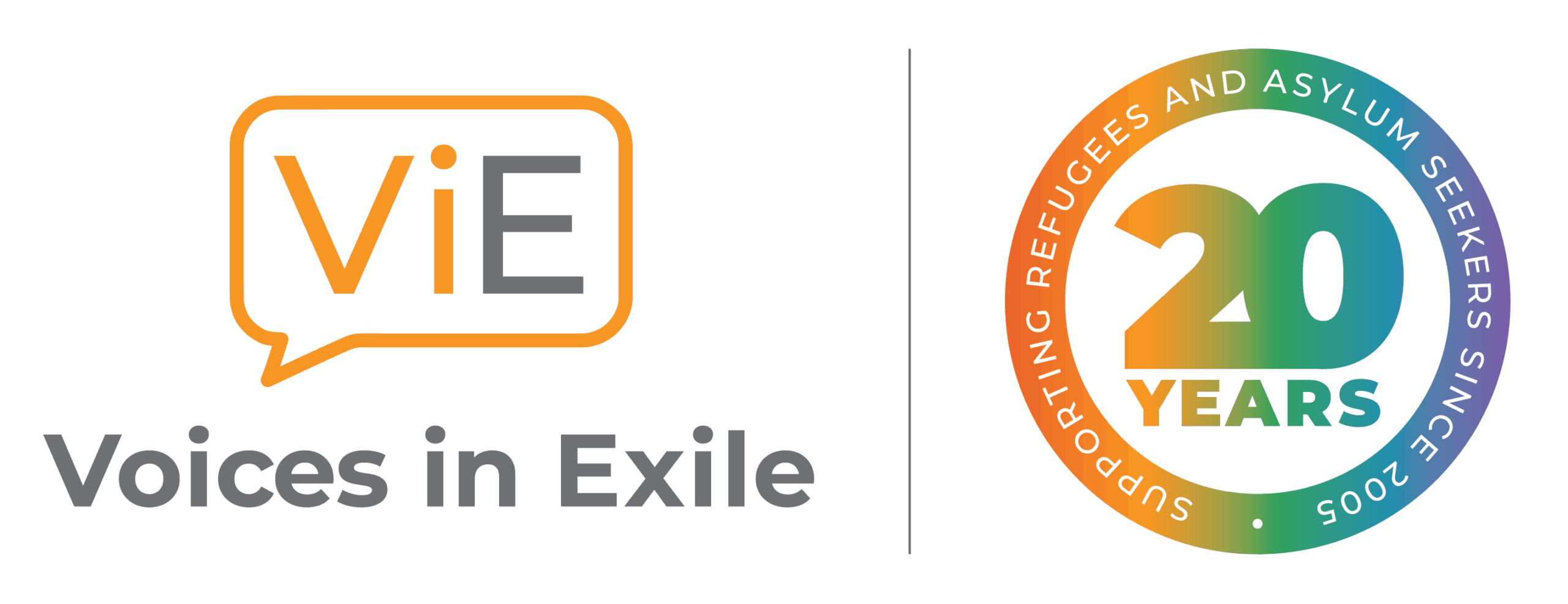Resources
Myth-busting FAQs
This resource addresses some of the most common myths and misconceptions about refugees, asylum seekers and migrants in the UK. Drawing on credible data, it sets out the facts to help build understanding and counter misinformation.
“We’re a small country — we can’t take everyone.”
It is understandable to be concerned about resources — but the UK actually takes in far fewer refugees than many other countries, despite being the 6th richest country in the world.
According to the UN, the vast majority of the world’s refugees are hosted by developing countries, not wealthy ones like the UK. Countries like Turkey, Pakistan, and Uganda host millions — while the UK hosts just over 1% of the world’s refugees.
We are not “full.” The UK has the space, wealth, and infrastructure to offer safety to people fleeing war and persecution. What’s often lacking is political will — not capacity. Being one of the wealthiest countries in the world means that we can support those who need help, whether they are from the UK or originated from somewhere else, but we have to be clear with our politicians that they are responsible for how wealth is distributed in society. We mustn’t let them pull the wool over our eyes by blaming migrants.
“Migrants just come here to live off benefits.”
This is a common myth — but it’s not true.
Most migrants come to work, not to claim benefits. In fact, they’re statistically less likely to claim benefits than British citizens.
Refugees often arrive with nothing, and yet many go on to start businesses, work in vital industries, and contribute far more in taxes than they ever take out. The NHS, construction, care work, food production — all rely heavily on migrants to function.
Focusing on people who come here to rebuild their lives does nothing to solve poverty or fix our economy. Blaming the most vulnerable distracts from the real issues that governments should be addressing.
“Why don’t they stay and fight for their country?”
Imagine your home is bombed. Your neighbours are killed. Your government is persecuting you for your ethnicity or beliefs. No-one wants their children growing up in that environment, and we can all empathise with parents who would do anything to protect their loved ones.
Refugees don’t flee because they want to — they flee because they have no choice. Many of them have fought for their countries – sometimes to support British troops overseas. Others are fleeing regimes where dissent is met with imprisonment, torture, or death.
Leaving your home, often making dangerous journeys and then having to build a life somewhere you may not speak the language or understand how things work – that takes real bravery.
“I feel like they get housing and support before British people.”
Housing shortages are real — and they affect everyone. But refugees are not the cause of this crisis.
Only around 0.2% of social housing goes to refugees – that’s two in every thousand. The real cause of the housing crisis is decades of underinvestment and poor policy decisions — not migration.
Pitting struggling locals against refugees fuels division. We should be angry at policies that fail to fund housing, not at the people who are just trying to survive.
Tax Justice UK estimates that large companies avoid paying over £388 billion pounds in tax per year – this is money that could go towards housing, health care and other vital resources. https://taxjustice.uk/blog/a-third-of-global-tax-dodging-is-enabled-by-the-uk-and-british-overseas-territories/
“They should come through the proper channels.”
We hear this a lot — but here’s the truth: for most refugees, there are no safe or legal routes to apply for asylum in the UK.
People fleeing war zones like Syria, Afghanistan, or Sudan often have no embassy or safe path to apply through. UK law requires someone to be on British soil to claim asylum — which is why many people take dangerous journeys.
If we want to stop small boats, the answer is to create safe routes that people can use.
Asylum seekers make up 7% of migrants in this country but take up most of the headlines – most migrants make costly immigration applications to come here to work, join families or study.
“Charities only care about migrants, not British people.”
At Voices we care about everyone. In fact, our work helps make the UK stronger — economically, socially, and morally.
By supporting migrants and refugees, we’re standing up for compassion, justice, and human dignity — values that benefit all of us.
And many migrants are British. Refugees who settle here raise families, pay taxes, and become proud, active members of their communities. Our country is better for it. Without immigrants our public services would not be able to function. More than 17% of all NHS staff are from overseas, rising to 27% (or around 100,000 people) for nurses, the lifeblood of the NHS.
About 1,200 medically qualified refugees are recorded on the British Medical Association’s database. It is estimated that it costs around £25,000 to support a refugee doctor to practise in the UK, whereas training a new doctor is estimated to cost between £200,000 and £250,000.
While British natives generally use a greater share of public finances by being born and educated here, most migrants move to this country once they are of working age. The Office of Budget Responsibility has projected that the average migrant, who moves to this country at the age of 25 and lives until 80, will contribute £341,000 to public finances over the course of their lives – more than the average UK born citizen. Compared to the average UK adult, skilled worker migrant tax receipts were approximately £4,100 higher, providing a much-needed boost to the Treasury. And if immigrants are unemployed, they are less likely than UK-born citizens to claim unemployment benefits - 22% compared to 31%.
“What do migrants actually bring to the UK?”
So much. Here’s a snapshot:
- The NHS would collapse without them — nearly 1 in 5 NHS workers are from overseas.
- Entrepreneurship — migrants are twice as likely to start businesses.
- Cultural richness — from food to music to sport, migrants shape the best of Britain.
- Demographic balance — as the UK population ages, we need young workers to keep the economy moving.
“But shouldn’t we look after our own first?”
Welcoming refugees doesn’t mean turning our backs on struggling communities — it means building a fairer society for everyone. Solidarity isn’t a zero-sum game: one person’s gain is not equal to another person’s loss. Supporting refugees is not at the expense of others, it is part of creating a society that helps all of those in need and benefits everyone – and migrants are particularly beneficial for the UK.
Final thought
Behind every refugee is a person — a parent, a teacher, a student, a neighbour — who just wants to live in safety and dignity.
The same system that fails vulnerable British people is the one that mistreats migrants. We believe in fixing that system — not scapegoating its victims.
At Voices, we believe that welcoming migrants doesn’t weaken us. It defines us. And it reflects the best of who we are.
Immigration toolkit
Voices in Exile has created a bespoke immigration toolkit to assist service users going through various immigration applications.
The toolkit features breakdowns of evidence needs, guides on how to gather evidence, and online forms needed.
This resource can be used by anyone submitting these applications, and is not just for Voices in Exile clients. Please share the toolkit with whomever may find it useful.
Immigration toolkit resources
How to: Write a Witness Statement
Clearly outline your observations or experiences, including relevant dates, times, and details. Use a structured format, with your name, date, and signature. Ensure the statement is truthful, concise, and free of errors.
How to: Send identification
Provide a clear copy of your ID (passport, driving licence, or other official document). Ensure details are visible, and send securely via email or post, following instructions. Keep a copy for your records.
How to: Send Financial Evidence
Collect documents such as bank statements, payslips, benefit letters, or rent receipts. Ensure they are recent, accurate, and clearly show your financial situation. Organise and store them securely.
How to: Send a Bank Statement
Obtain a recent statement, ensure your name is visible, redact sensitive details if needed, and send securely via email or post. Keep a copy for your records.
How to: Prove Evidence of Contact
Provide records such as emails, text messages, call logs, or letters demonstrating communication. Include details like dates, times, and names of the individuals involved. Ensure evidence is organised, clear, and securely stored.
How to: Letterheads and Official Paperwork
Use the organisation’s official letterhead for all formal communications. Ensure it includes the charity’s name, logo, address, registration details, and contact information. Proofread all documents for accuracy, maintain a professional tone, and keep copies for records.
How to: Send Information to Your Caseworker
Gather all required documents and information relevant to your case. Clearly label each item with your name and case reference number. Send the information securely via email or post, following your caseworker’s preferred method of communication. Always keep copies of everything you send.
Refugee Travel Documents
Official documents issued by the UK Home Office to refugees recognised under the 1951 Refugee Convention, enabling international travel when they cannot use their national passports.
Refugee Family Reunion
A process allowing immediate family members (spouse/partner and children under 18) of a person granted refugee status or humanitarian protection in the UK to apply to join them, promoting family unity.
Leave to Remain: Private Life in the UK
Permission granted by the UK Home Office allowing a person to stay in the UK based on their established private life, such as long residence, significant ties, or other compelling circumstances under immigration rules.
Leave to Remain: Partner
Permission granted by the UK Home Office allowing a person to stay in the UK based on their relationship with a British citizen, someone settled in the UK, or a person with refugee status or humanitarian protection.
Leave to Remain: Parent
Permission granted by the UK Home Office allowing a person to stay in the UK for a specific period or indefinitely, depending on their application and circumstances.
Fee waiver
A fee waiver application may be submitted if you do not have the funds to pay for Home Office application fees or the Immigration Health Surcharge.
How to: Write a Witness Statement
All Witness Statements Must Include:
- Name of author (person who is writing the statement)
- Address of author
- Date
- Full names of any person mentioned
- Location details
- Date of event mentioned
- Signed by the author
All witness statements must be sent with a copy of the author’s identification
Example
This is an example of a witness statement.
Scenario
Liza needs to provide evidence of her relationship with her husband Mo.
Ahmed is Liza’s cousin and he attended her wedding to Mo. Ahmed is providing a witness statement to confirm the wedding event. It is important that Ahmed provides details about the date and location of the wedding. These details need to match the details of Liza and Mo.
Ahmed has also provided evidence of visiting Liza and Mo in their home in Idlib. It is important to add as much detail as possible to help Liza’s application. Ahmed has included Liza and Mo’s address and the dates that he visited.
To confirm these dates, Ahmed can provide proof of texts and phone calls that arrange the meeting.
Proof of contact Guide
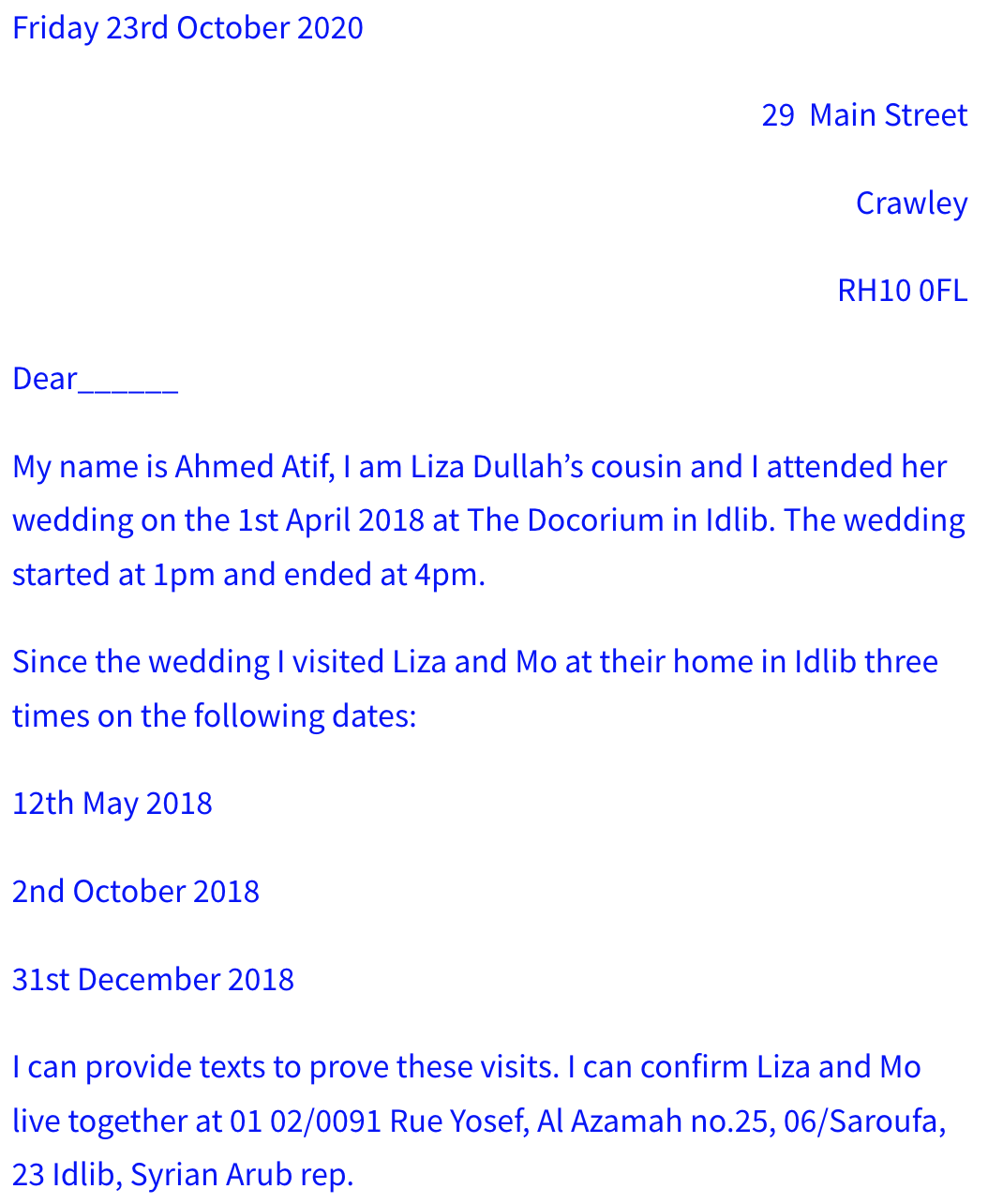
Once you have gathered all of the evidence needs for the application, you will need to record and send it to your caseworker. This page shows you how to use a photocopier & scanner, how to printscreen pages from your computer and phone, and how to electroncially send documents to your caseworker.
How to: Send identification
Identification (ID) proves who you are, it is an official document that can show name, date of birth, nationality, and address
Examples:
- Passport
- Biometric Residence Permit
- National ID Card
You will need to either scan the ID document or take a good, clear photo and send it to your caseworker.
Make sure your image is clear, straight, includes all the information.
Passport scans must show all stamped pages.
BRP’s must include the front and the back.
The same rules apply for official certificates, such as birth or wedding certificates.
Make sure all of the information is clear, and to include both sides.
Passport
Include images of every stamped page in your passport.
Make sure the information is clear and can be eaaily read.
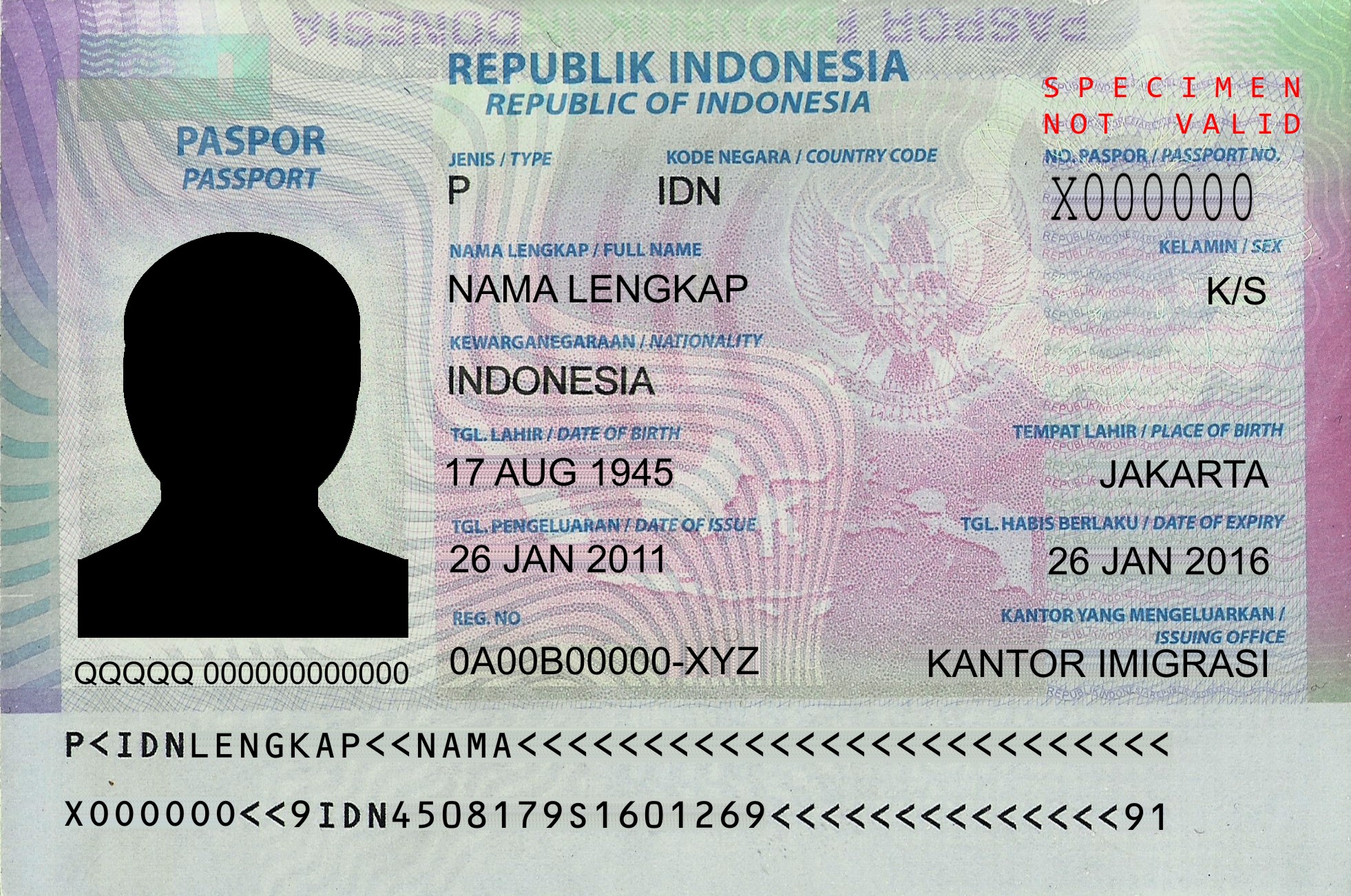
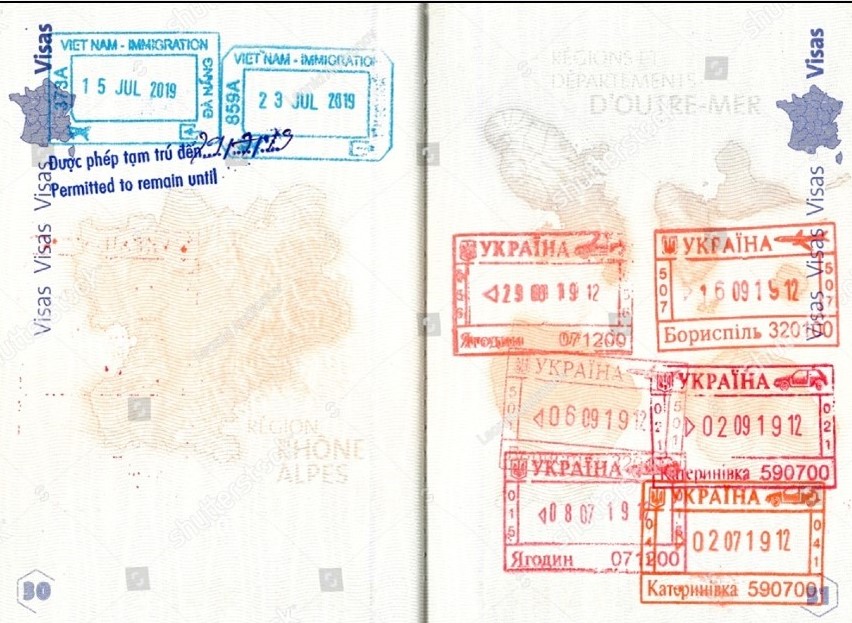
Biometric Residence Permit (BRP)
Make sure all the information is clear and can be easily read.
Include both sides of the BRP card
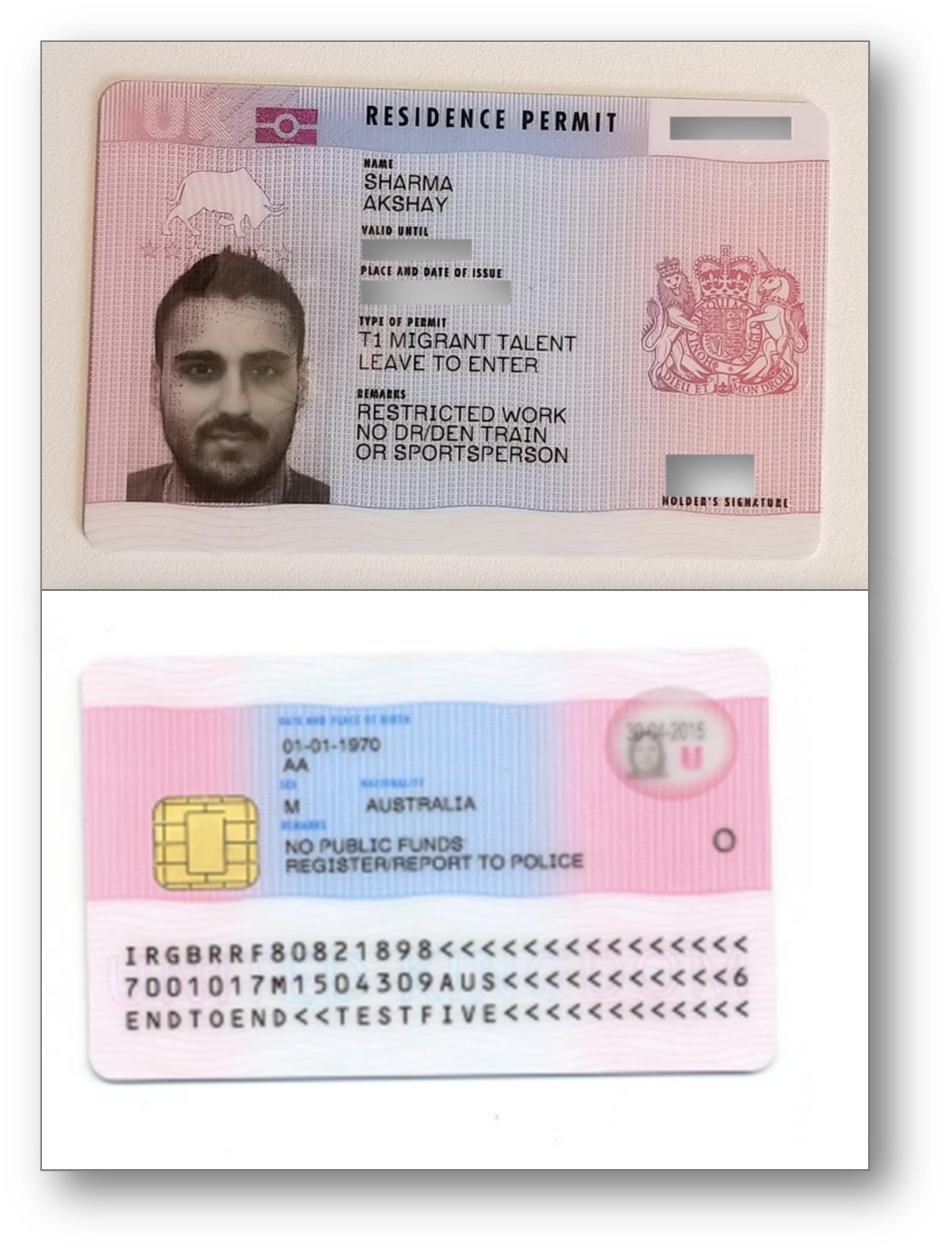
Once you have gathered all of the evidence needs for the application, you will need to record and send it to your caseworker. This page shows you how to use a photocopier & scanner, how to printscreen pages from your computer and phone, and how to electroncially send documents to your caseworker.
How to: Send Financial Evidence
Financial evidence proves what money you have, and where it is coming from.
Bank statements
You must include statements from all accounts you hold. Even if the accounts are empty or have not been used in a long time.
The statements must be from the last 6 months.
The end date on the statement must be as close as possible to the date that you provide your bank statements to your caseworker. All bank statements must end within 28 days of the date of application. For example, if you give your bank statements to your caseworker on the 30th October, the latest date from the bank statement must not be before the 2nd of October. Your caseworker may ask you to send additional bank statements.
Bank statements must be authorised and stamped by the bank. Ask your bank to print and stamp your bank statements.
Bills
Bills are any outgoing charges you have from a company that provides a service.
For example:
- Gas & electric
- Water
- Internet
- Phone bill
- Council tax
You need to provide copies of any physical or online bills and receipts for these payments. You must provide proof of the bill even if you have not or cannot pay it.
Incoming and outgoing money
If you have received or sent out money to anyone over the amount of £50 you must explain it.
You must provide a witness statement confirming:
- The amount of money
- Who the money was sent to/from
- Why this transaction happened
- What is the specific reason for the money, for example: loan, gift.
- When the money is going to be returned
The witness statement must include full names of everyone involved, the relationship between the people involved, it must be signed, dated and include a copy of their identification.
Section 17 support
If you are receiving section 17 support, you must provide a letter from your social worker confirming:
- How much money you are receiving
- What accommodation is being provided
- When this support began
- How much money you receive per week or month
- Why you are receiving this support
- Whether the support can continue
Once you have gathered all of the evidence needs for the application, you will need to record and send it to your caseworker. This page shows you how to use a photocopier & scanner, how to printscreen pages from your computer and phone, and how to electroncially send documents to your caseworker.
How to: Send a Bank Statement
You must include statements from all accounts you hold. Even if the accounts are empty or have not been used in a long time.
The statements must be from the last 6 months.
The last date on the statement must be less than 28 days old, up until the date you give the evidence to your caseworker.
-For example, if you give your bank statements to your caseworker on the 30th October, the latest date from the bank statement must not be before the 2nd of October.
Bank Statements
This is an example of a full bank statement scan. It shows that the statement is official, as it is on the bank’s headed paper, showing the bank name, logo and address.
All bank statements need to be stamped by the bank. You can go into the bank branch and ask them to print your statements and to stamp them to mark them as official.
Make sure all your bank statements are in date order.
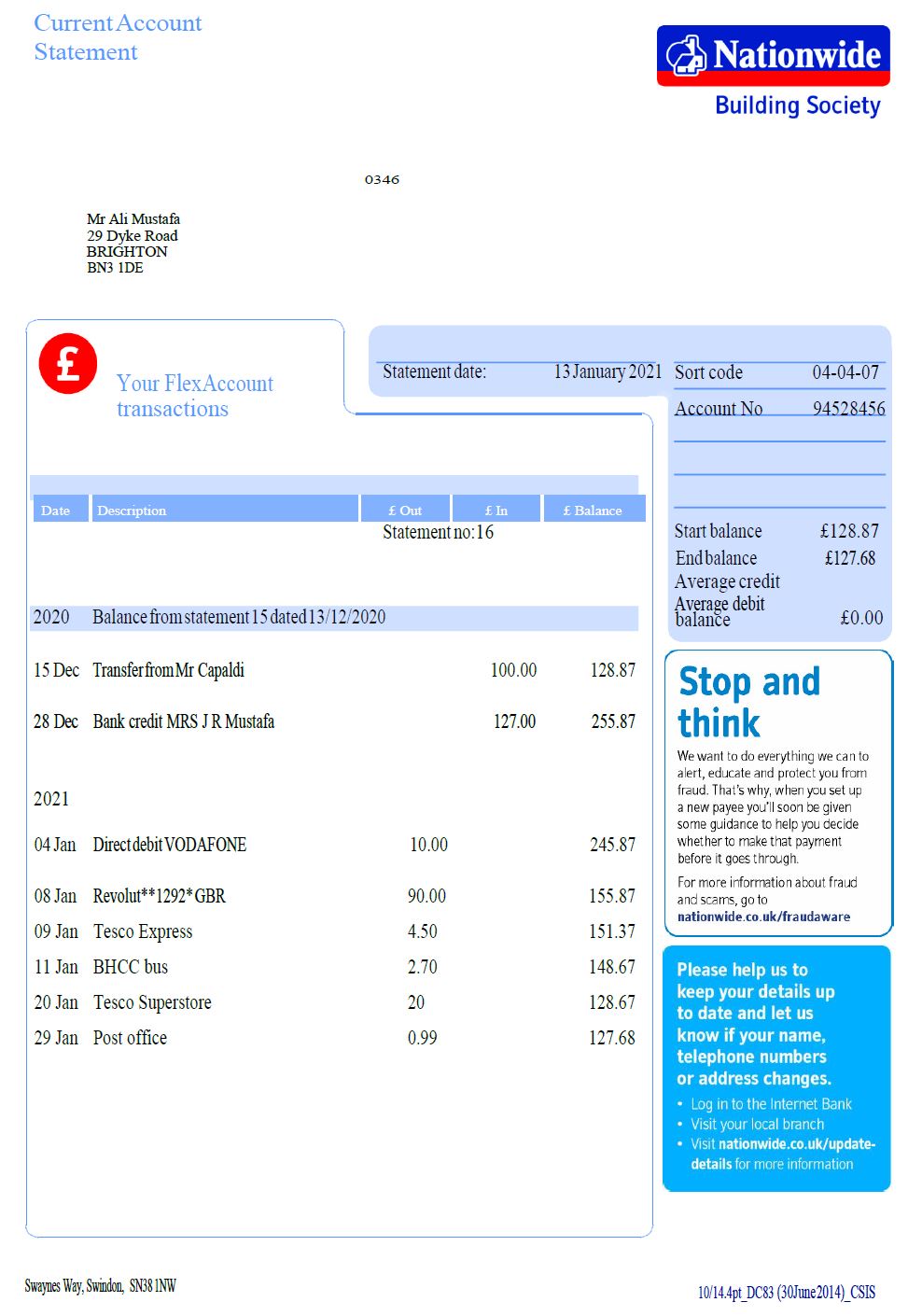
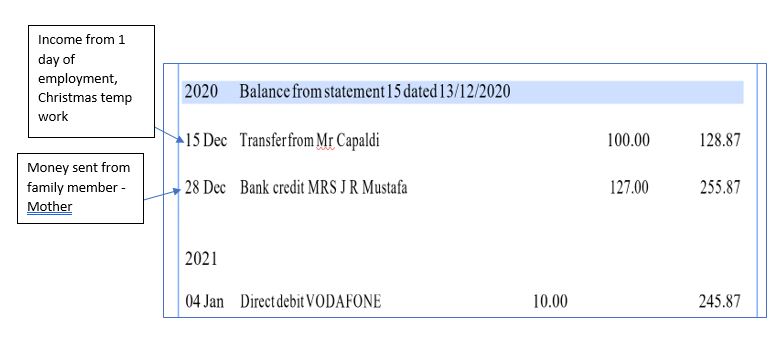
Incomings & Outgoings
This bank statement shows money being paid into an account from an employer, and a family member.
You must declare if you are receiving money outside of your regular income that is over £50
Sending Scans
Good Scan
![]()
This scan is good because:
- It is straight
- The text is clear
- It contains essential details: amount, date, names, address.
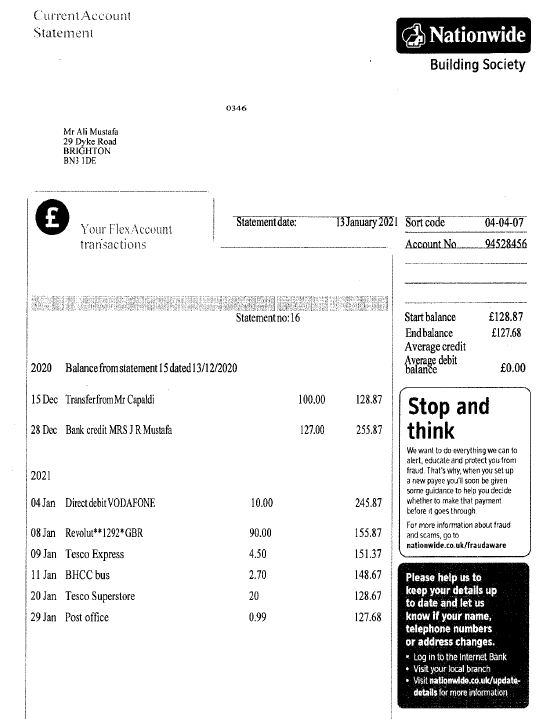

Bad Scan
![]()
This scan is bad because:
- It is not the whole page
- It is not straight
- Information has been crossed out
- Some details are missing
Once you have gathered all of the evidence needs for the application, you will need to record and send it to your caseworker. This page shows you how to use a photocopier & scanner, how to printscreen pages from your computer and phone, and how to electroncially send documents to your caseworker.
How to: Prove Evidence of Contact
How to show Evidence of Contact and Living Together
You may need to provide proof of contact to show you have had communication with someone relevent to your application.
This can include communication via text, phone call, social media or email.
It also includes proof that you live with that person, for example: both your names are on bills and letters, sharing a tenancy agreement, signing a mortgage etc.
Please make sure all your documents are in date order when you send them.
All evidence of contact must include:
Communication
- Names
- Phone numbers
- Dates
- Usernames/handles (for social media)
Living together
- Dates
- Names
- Address
Call Logs
Calls logs can provide evidence of phone calls between you and the relevant person.
Make sure to include the time and date, and to highlight the contact you are proving communication with.

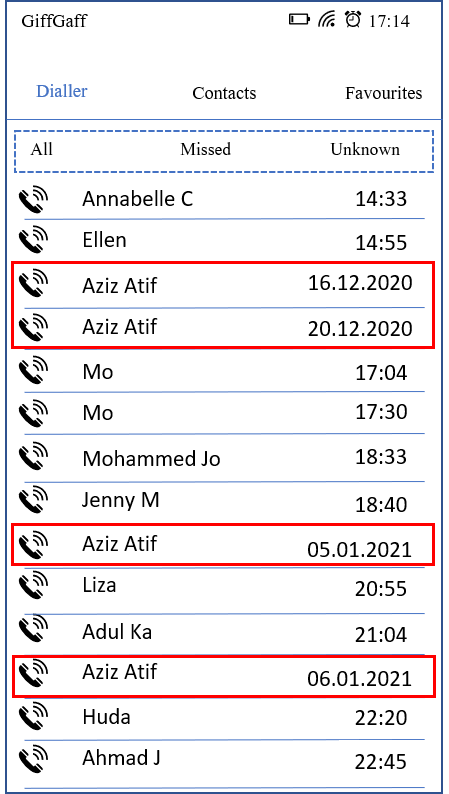
Name & Number
Show the contact name and telephone number
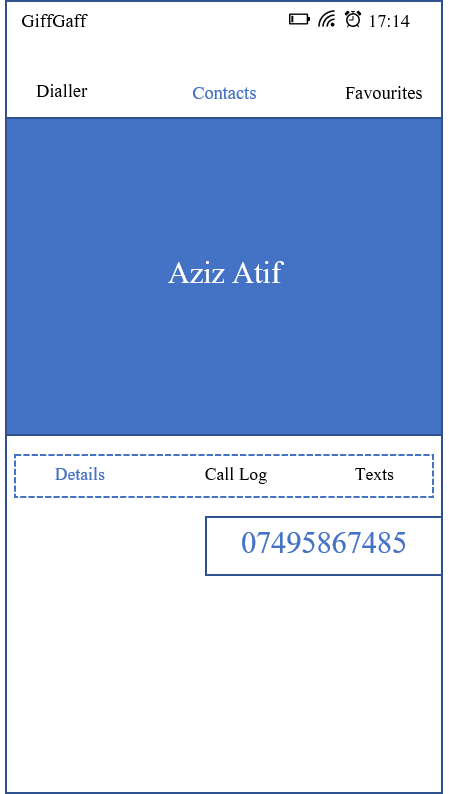
Contact via Social Media
You can show proof of communication via social media messages.
Make sure to include the person’s username or social media ‘handle’ for example: @aliwizz
All messages should show dates and times.
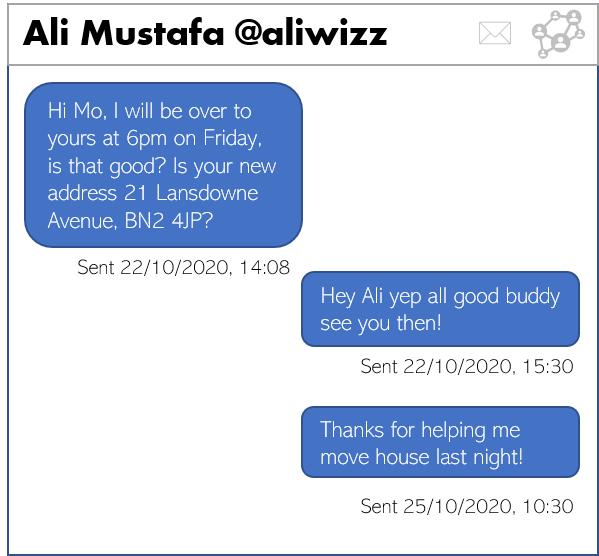
Proof of Living Together
Addresses & Post
You must provide 6 items of post addressed to both you and your family member or partner at the same address.
For example: utility bills, letters from government departments or agencies, letters from GP or doctor, letters from school, council tax, tenancy agreement
The evidence must show you have been living together since your last grant of leave OR for the past 2 years if this is your first period of leave in this country.
The dates of evidence should be spread even over the whole period you are giving evidence for.
They should be from at least 3 different sources.
If you do not have enough evidence that shows both names per item of evidence, you can provide separate evidence. They need to show names and the same address.

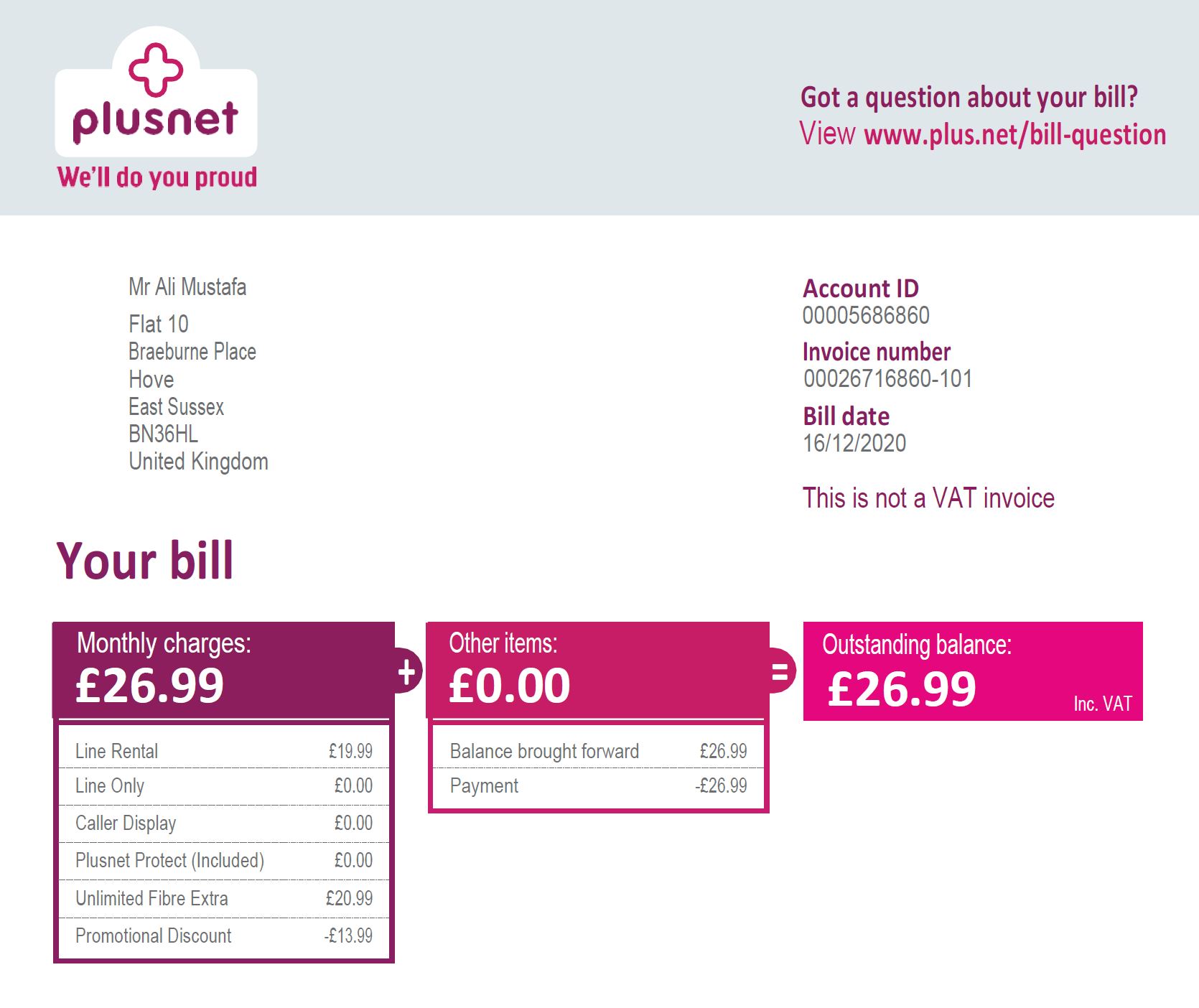
Example: Utility Bill (internet)
The document must show both names and the address.
It must also include the date of the bill.
Once you have gathered all of the evidence needs for the application, you will need to record and send it to your caseworker. This page shows you how to use a photocopier & scanner, how to printscreen pages from your computer and phone, and how to electroncially send documents to your caseworker.
How to: Letterheads and Official Paperwork
You may be asked to provide various documents from different sources, for example:
- Council tax bills
- Utility bills
- Tenancy agreements
- Letters from the Home Office
- Letters from school or employment
- Immigration paperwork
It is important all paperwork you submit is clear, straight, and the full page. All official paperwork must show the details of the company it came from.
Headed Paper
Some documents will specify the paperwork must be on ‘headed paper’
This means the document is official and from a trusted source.
The ‘header’ of the paper is at the top of the page, it will include information about the source, usually: name, addres, logo, contact information.
This is an example of a letter from the Home Office on headed paper. The scan is good quality, you can clearly see all the information and the page has been scanned straight.
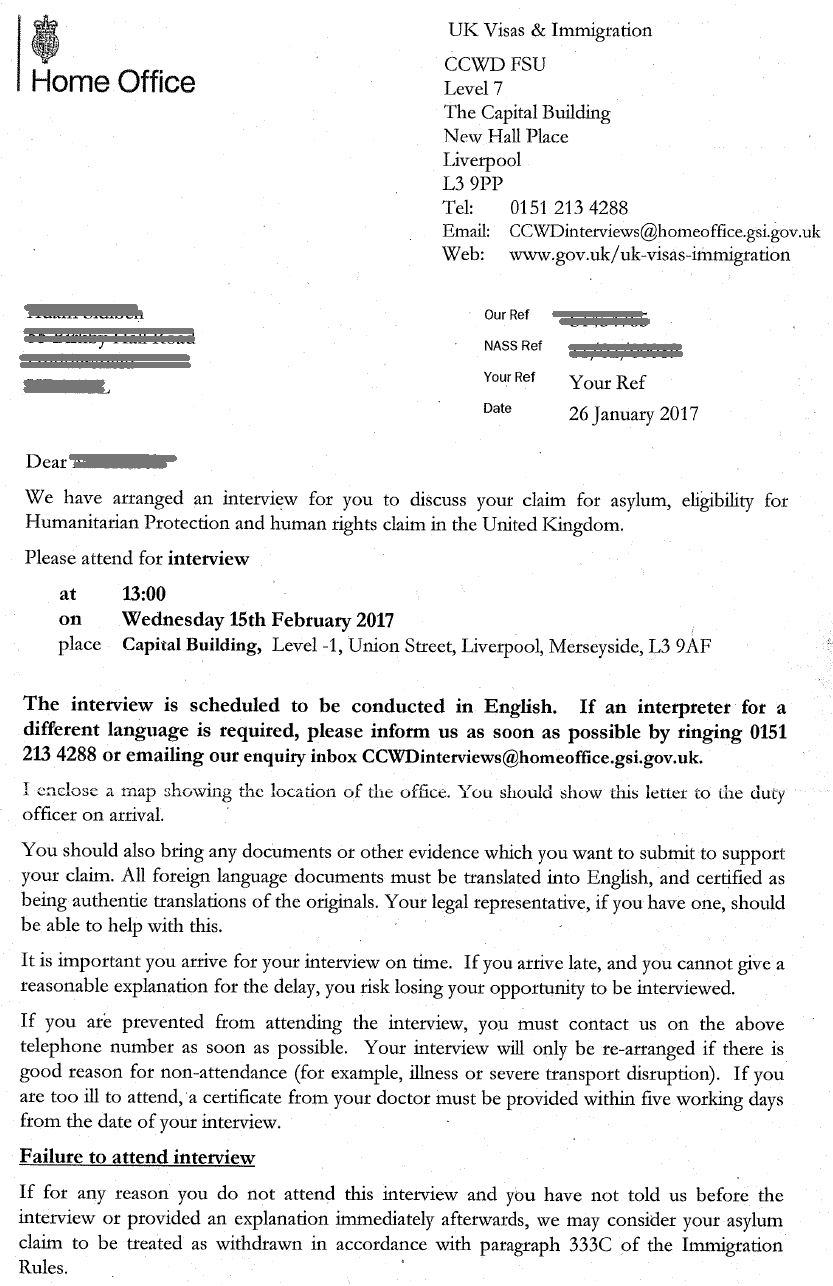
Utility Bills
Utility bills are documents from companies that provide a service, for example: Internet, water, electric, council tax etc.
You may need to provide a bill to prove outgoing costs.
This is an example of an internet bill. The bill shows the name and logo of the company, their website, and your information: name & address, account number
The bill also shows the money that is owed, and the bill date. This information must always be clearly visible when providing a utility bill as evidence.

Once you have gathered all of the evidence needs for the application, you will need to record and send it to your caseworker. This page shows you how to use a photocopier & scanner, how to printscreen pages from your computer and phone, and how to electroncially send documents to your caseworker.
How to: Send Information to Your Caseworker
Everything you send to your caseworker needs to be:
- Clear (not fuzzy, or blurred)
- Include the whole document (not have parts missing)
- Include the date
- Signed where necessary
- Be straight (not a wonky page)
Pay close attention to the evidence needs of your application, if you do not send everything correctly you will have to send it again.
Sending your paperwork

The easiest way to electronically send documents to your caseworker is via email. You can send the documents by attaching the files to an email. Emails can be sent by a laptop, phone, or tablet.
If you do not have an email account you can set one up with Gmail, Outlook, or Yahoo.
Please be sure to attach as many documents as possible in each email. Do not send an email for every document you send.
By Post

You can send physical documents to your caseworker in the post. They will make photocopies and send the paperwork back to you.
WeTransfer
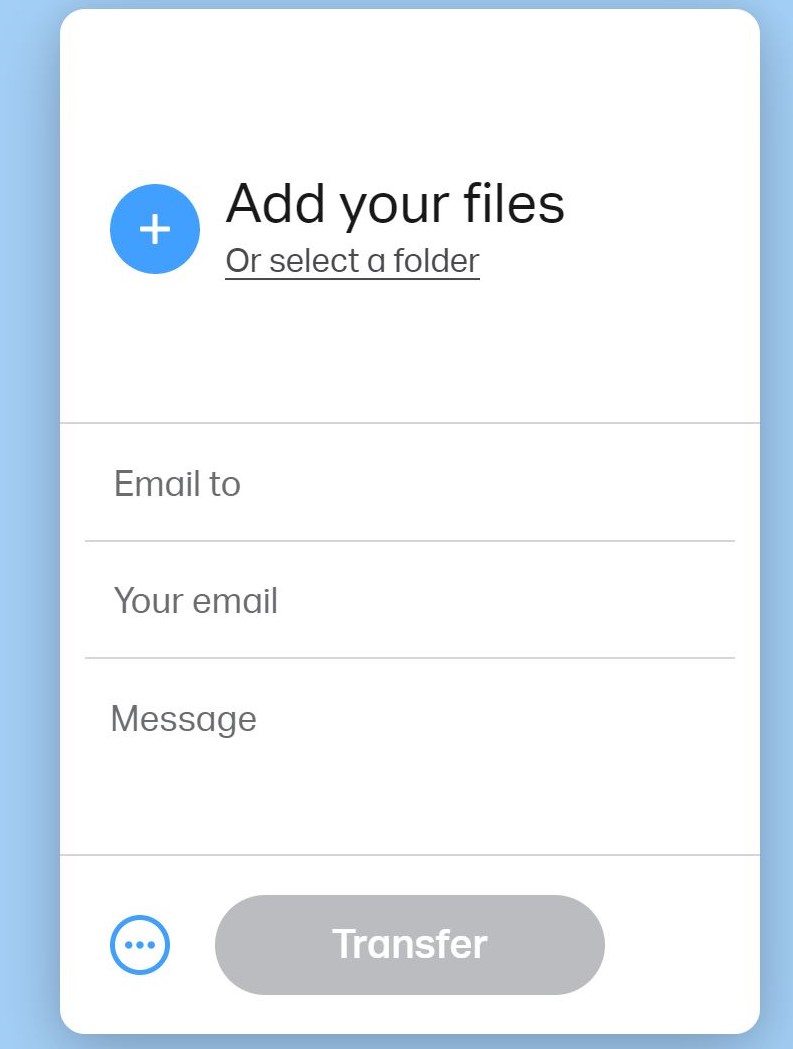
Sometimes when sending a lot of files at once, you need to use other tools to send the documents to your caseworker. WeTransfer.com can safely send your documents. You need to put your caseworker’s email, your email, and a message with your name and details, when you add your files.
Watch this YouTube video for help.
Scanning and Photocopying
Photocopying
A photocopy is a paper copy of your paper document. It is the same as printing the document again. You can send the physical paper documents to your caseworker in the post. Make sure your paper photocopy is exactly the same as your original.
Scanning
Scanning takes electronic copies of your paperwork and saves them to your computer.
When using a scanner, make sure your paperwork is clean and straight – the scanned image must match the original.
If you do not have access to a printer or scanner, you can go to your local library.
Most printers also have a scanning option.
Jubilee library is Brighton’s main library, Brighton and Hove libraries.
If you do not live in Brighton, find your local library online.
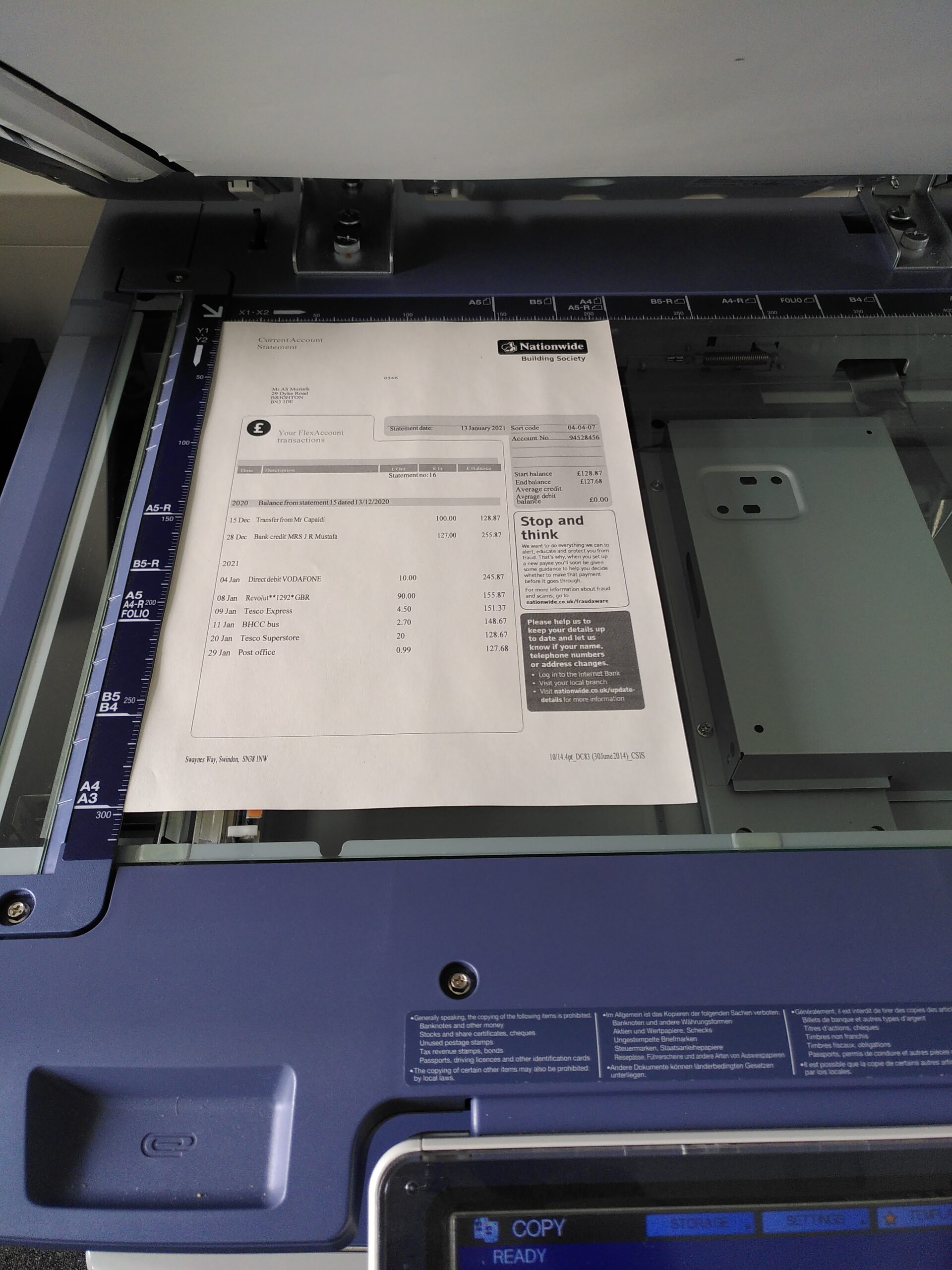
How to take Screenshots and Printscreen
Printscreen on a computer
Printscreen takes a picture of what’s on your computer screen. You can find the print screen button on your computer keyboard, usually displayed as ‘PrtSc’ or something similar.
After pressing the printscreen button, you will need to ‘paste‘ your print screen picture somewhere. You can paste directly into an email to your caseworker, or in to a word document to save alongside other photos or printscreens.
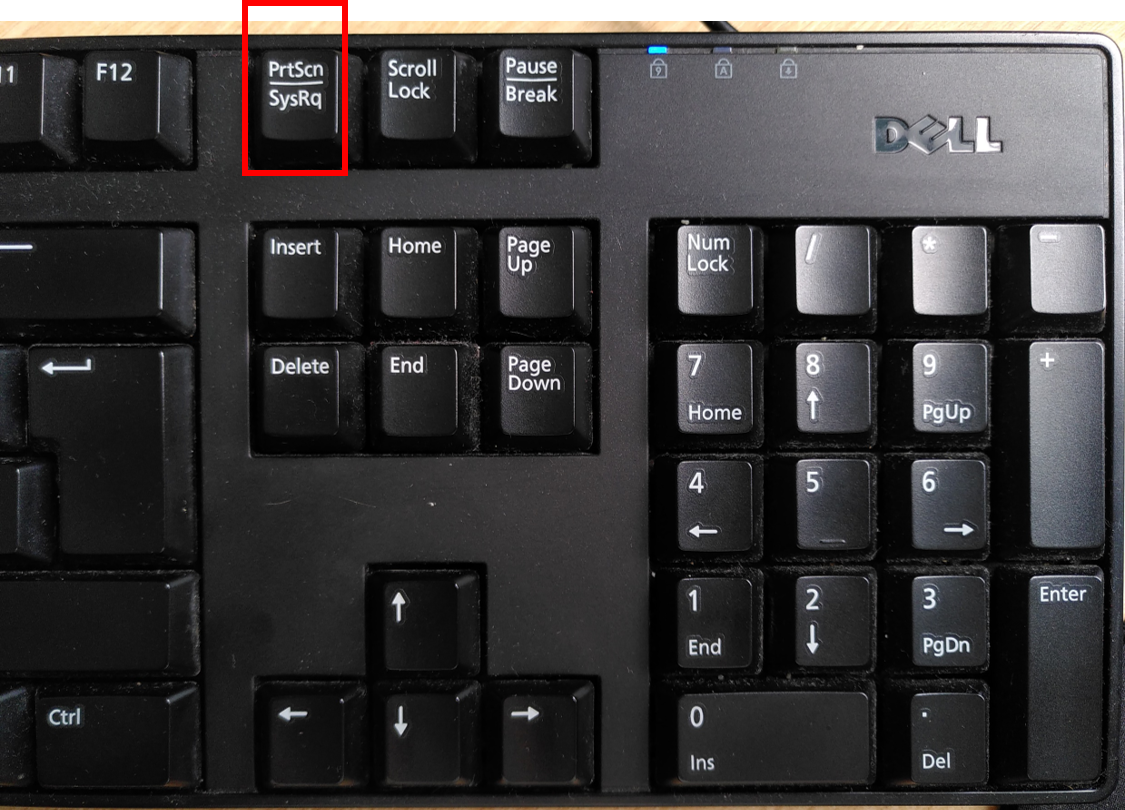

Screenshot on a phone or tablet
Taking a screenshot on a phone takes a picture of whatever is on your screen at the time. This varies depending on what phone you have.
Usually, you take a screenshot by pressing the ‘on/off’ button and the ‘home’ button at the same time. Or the ‘on/off’ button and a ‘volume’ button at the same time.
Your screenshots will all be saved in the same folder in your phone, usually with your pictures.
How to take a screenshot on any device You can also use www.youtube.com and type in your phone make/model, and ”how to screenshot”
Scan examples
Good Scan
![]()
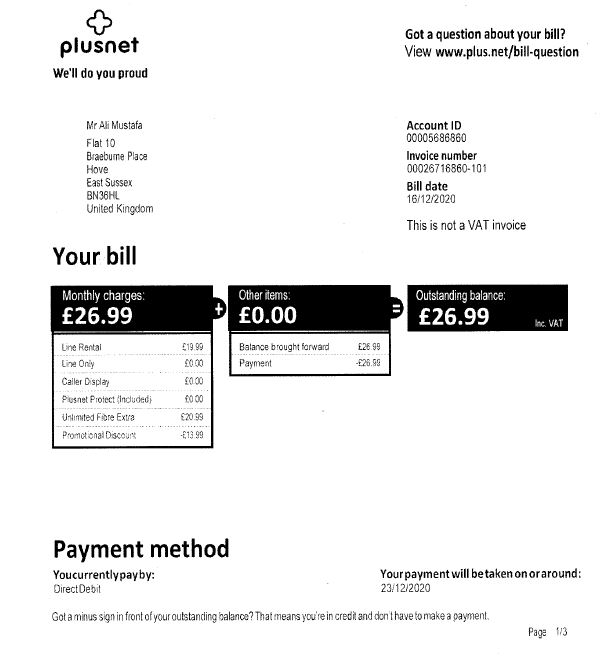
This scan is good because:
- The whole document is visible
- The text is clear
- There is contrast between white background and black text
- It is straight
Bad Scan
![]()
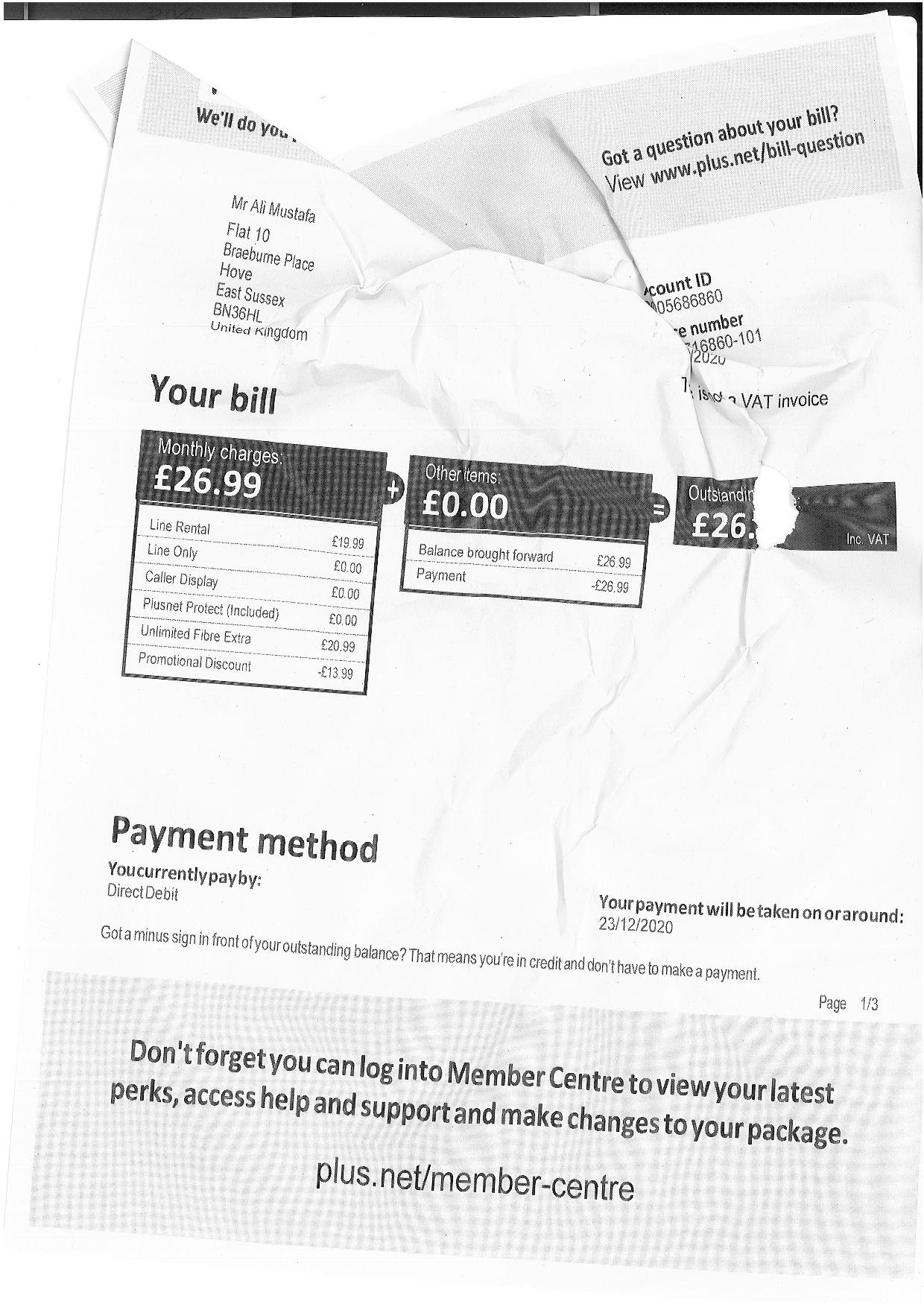
This scan is bad because:
- The document has been edited with pen
- You cannot see all the text
- Parts are missing
- It is not straight
- It is folded and crumpled
Good Photograph
![]()

This scan is good because:
- It is clear
- It is good quality
Any photographs you submit must be labelled with the people who are in the photo.
Bad Photograph
![]()

This photo is bad because:
- Parts are missing
- It is bad quality
- You cannot see all the faces
- The photo is damaged
Refugee Travel Documents
What is a Refugee Travel Documents application?
Refugee Travel Documents: You can apply for a Home Office travel document if you have Refugee status and would like to travel outside of the UK. An Adult Travel Document costs £94.50 for adults (it’s free if you were born before 1 September 1929) and a child Travel Document costs £61.50 for children 15 or under. Some countries do not accept Refugee Travel Documents or require you to meet certain visa requirements before travel.
Application Requirements
All documents need to include a date, and a signature where necessary. Documents that need a signature are: letters, tenancy agreements, forms, certificates, or any evidence you get from someone else (your employer)
Gather as much evidence and information as you can.
It is important you send your documents in a clear and organised method.
What do I need?
These documents are essential for the refugee travel documents application.
- VIE consent form
- Copy of Biometric Residence Permit(s)
- Tenancy/housing agreement for current property
- 2 passport photographs
Additional Documents
Please provide the following if you have them:
- National passport(s)
- National ID card(s)
- Leave to remain status letters
- Current or expired Home Office travel documents
- European Uniform Format Forms on with visas attached
- National Insurance Number (if not shown on BRP)
If children are applying
You must provide one of the following
- Birth certificate
- Letter from parent giving consent
- Court Order that parent/guardian has parental responsibility
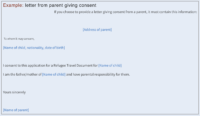
Once you have gathered all of the evidence needs for the application, you will need to record and send it to your caseworker. This page shows you how to use a photocopier & scanner, how to printscreen pages from your computer and phone, and how to electroncially send documents to your caseworker.
Refugee Family Reunion
What is a Refugee Family Reunion application?
Refugee Family Reunion allows your partner and/or children that lived with you in your country of origin to join you in the UK. If their application is successful, your family members will have the same permission to live in the UK as you. There are no financial or English language requirements in an application for Refugee family Reunion.
Application Requirements
All documents need to include a date, and a signature where necessary. Documents that need a signature are: letters, tenancy agreements, forms, certificates, or any evidence you get from someone else (your employer)
Gather as much evidence and information as you can.
It is important you send your documents in a clear and organised method.
What do I need?
These documents are essential for the refugee family reunion application.
- Biometric Residence Permit
- Travel document
- Letter confirming refugee status or appeal determination
- VIE Consent form
- Screening interview (first short asylum interview) notes
- Substantive (main asylum interview) notes
- Witness statements from asylum claims
Documents needed from all family members:
- Passport/travel document
- EU Uniform format form (if no passport)
- Any other form of ID
If you are applying for your spouse or partner
- Marriage/civil partnership certificate
- Divorce certificate (if in previous relationship)
- Evidence that you lived together e.g. Joint postal address
- Both names being on bills
- Photos of you together – including at wedding
- Witness statements from people at wedding
- Evidence of continued contact in UK
- Communication evidence: emails, texts, phone records.
- Witness statement confirming relationship and continued contact
If you are applying for your child/children
- Birth certificate
- Evidence you had parental responsibility – Doctors/school
- Evidence that you lived together
- Witness statement from child (if old enough)
- Records of contact since being in UK
- Photos of you with your children.
Once you have gathered all of the evidence needs for the application, you will need to record and send it to your caseworker. This page shows you how to use a photocopier & scanner, how to printscreen pages from your computer and phone, and how to electroncially send documents to your caseworker.
Leave to Remain: Private Life in the UK
Application Requirements
All documents need to include a date, and a signature where necessary. Documents that need a signature are: letters, tenancy agreements, forms, certificates, or any evidence you get from someone else (your employer)
Gather as much evidence and information as you can.
It is important you send your documents in a clear and organised method.
You can apply for Leave for Remain on the basis of your Private Life in the UK if any of the following you:
-
If you have lived continuously in the UK for at least 20 years (discounting any period of imprisonment)
- If you are under the age of 18 and have lived continuously in the UK for at least 7 years (discounting any period of imprisonment) and it would not be reasonable to expect you to to leave the UK.
- If you are aged 18 years or above and under 25 years and have spent at least half of your life living continuously in the UK (discounting any period of imprisonment).
-
If you are aged 18 years or above, have lived continuously in the UK for less than 20 years (discounting any period of imprisonment) but there would be very significant obstacles to your integration into the country to which you would have to go if required to leave the UK.
Private Life in the UK
These documents are essential for the Leave to Remain application.
- VIE consent form signed on all pages, select the tick boxes to show who we can contact.
-
Home office verification checks form
One of the following:
-
Valid passport
-
Valid national ID card (not BRP)
-
Expired passport
-
Expired national ID card
If you do not have any of the above you must provide an explanation as to why an ID document cannot be provided. It is helpful to have written evidence as to why you are unable to obtain an ID document.
-
6 months of bank statements all accounts you hold, including savings account, building society savings books, payslips or other formal documents showing income for the last 6 months.
Evidence of public funds
-
Most recently received letters confirming what welfare benefits you receive, e.g child tax credits, child benefits or DWP
Documents provided must cover each year for the whole length of the claimed period of residence. Some examples of evidence of residence in the UK are:
-
Home Office letter(s) or other document(s) granting leave to enter and/or remain in the UK
- Doctor’s letter(s) showing registration and letters from hospital(s) or other local health service(s)
-
Council tax letter(s) or bills
-
Gas, electricity and water or other domestic bills or statements for each year.
-
National Insurance contribution records or P60/P45 forms.
-
HM Revenue and Customs/Inland Revenue letter(s) and/or P60 statements of income tax paid.
-
Employer(s) letter(s) confirming dates of employment. Department for Work and Pensions letter(s) and letters or other documents from other government departments or agencies.
-
Full birth certificate(s) which show the parents’ names for any children.
-
Mortgage document(s) showing any property owned in the UK and/or a letter from the landlord confirming the period of tenancy.
-
Other official documentation on headed paper.
-
For any children included on the application, items addressed to them, or official documents/ letters on headed paper all evidencing the child’s continuous residence, for example, letters from a GP or hospital, letters from nursery/school etc.
Once you have gathered all of the evidence needs for the application, you will need to record and send it to your caseworker. This page shows you how to use a photocopier & scanner, how to printscreen pages from your computer and phone, and how to electroncially send documents to your caseworker.
Leave to Remain: Partner
What is a Leave to Remain ‘Partner’ application?
If your partner is British, settled in the UK, an EEA national, has Refugee status, or is in the UK with Humanitarian Protection, you may be able to apply for Leave to Remain on the basis of your relationship with them. There are also requirements to show a good level of English and income that usually need to be met in order to succeed in this type of application.
Application Requirements
All documents need to include a date, and a signature where necessary. Documents that need a signature are: letters, tenancy agreements, forms, certificates, or any evidence you get from someone else (your employer)
Gather as much evidence and information as you can.
It is important you send your documents in a clear and organised method.
What do I need?
These documents are essential for the Leave to Remain ‘Partner’ application.
VIE consent form signed on all pages, select the tick boxes to show who we can contact
Home office verification checks form
One of the following:
-
Valid passport
-
Valid national ID card (not BRP)
-
Expired passport
-
Expired national ID card
If you do not have any of the above you must provide an explanation as to why an ID document cannot be provided.
- Biometric residence permit (if issued) Also for the dependant
-
bank statements, building society savings books, payslips or other formal documents showing income for the last 6 months.
-
6 months of bank statements All accounts you hold, including savings account
Evidence of public funds
-
Most recently received letters confirming what welfare benefits you receive, e.g child tax credits, child benefits or DWP
Additional Documents
For your Partner
A partner is a spouse/civil partner/living together for 2 years.
If you have a partner in the UK, you must provide the below documents
Your partner must provide these documents, and be submitted to the caseworker by the applicant.
-
Valid passport, national identity card or travel document showing his/her current immigration status
- Marriage certificate OR civil partnership certificate
Evidence of correspondence
-
6 items of correspondence addressed to you and your partner at the same address as evidence that you have been living together since your last grant of leave in this category, or for the past 2 years if this is your first period of leave in this category. The dates of the items of correspondence should be spread evenly over the whole period you are relying on. They should be from at least 3 different sources. If you do not have enough items in your joint names, you may also provide items addressed to each of you individually if they show the same address for both of you.
-
Letters or other documents from government departments or agencies, for example: Department for Work and Pensions, Driver and Vehicle Licensing Agency, TV Licensing
-
Letters or other documents from your GP, a hospital or other local health service about medical treatments, appointments, home visits or other medical matters
-
Bank statements / letters, Building society savings books / letters
Official documents and bills:
-
Council tax bills or statements
-
Electricity and/or gas bills or statements
-
Water rates bills or statements
-
Mortgage statements/agreement
-
Tenancy agreement(s)
-
Telephone bills or statements
If you have a child/children
You must provide your child’s documents:
-
ORIGINAL full birth certificate(s) which show the parents’ names.
-
Passports/travel documents to confirm your child’s immigration, settlement or citizenship status.
-
Biometric residence permit if your child has been issued with one since entering the UK.
-
Evidence of where your child/children normally lives and that you and/or any partner play an active role in their upbringing. This evidence should be dated within the last 3 months and can include:
-Official correspondence addressed to the child/children, doctor’s/hospital letters on official headed paper stating the child’s/children’s registered address
– School/nursery letter(s) on headed paper stating the child’s/children’s registered address.
-
If you have access rights to your child a court document issued by the courts showing your access rights; and/or evidence from your former partner that you have access rights.
-
Evidence of your and/or any partner’s parental responsibility for the child/children.
-
Evidence of where you and/or any partner lives, as the parent of the child/children.
-
Evidence of anything else you would like us to consider regarding your child’s life, both in the UK and outside the UK.
Once you have gathered all of the evidence needs for the application, you will need to record and send it to your caseworker. This page shows you how to use a photocopier & scanner, how to printscreen pages from your computer and phone, and how to electroncially send documents to your caseworker.
Leave to Remain: Parent
What is a Leave To Remain ‘Parent’ application?
If your child is under 18 and is British, settled in the UK, an EEA national or has lived in the Uk for 7 years, you may be able to make an application as a parent. You must have sole parental responsibility for your child or direct access (in person) to your child. There are usually also requirements to show a good level of English and to be able to house you, your child and other family adequately, and provide for them without needing recourse to public funds.
Application Requirements
All documents need to include a date, and a signature where necessary. Documents that need a signature are: letters, tenancy agreements, forms, certificates, or any evidence you get from someone else (your employer)
Gather as much evidence and information as you can.
It is important you send your documents in a clear and organised method.
What do I need?
These documents are essential for the Leave to Remain application.
- VIE consent form signed on all pages, select the tick boxes to show who we can contact.
Home office verification checks form
One of the following:
-
Valid passport
-
Valid national ID card (not BRP)
-
Expired passport
-
Expired national ID card
If you do not have any of the above you must provide an explanation as to why an ID document cannot be provided.
- Biometric residence permit (if issued) Also for any other dependence
-
bank statements, building society savings books, payslips or other formal documents showing income for the last 6 months.
-
6 months of bank statements All accounts you hold, including savings account
Evidence of public funds
-
Most recently received letters confirming what welfare benefits you receive, e.g child tax credits, child benefits or DWP
Additional Documents
If you have children under the age of 18 in the UK (or children who are over 18 and who have already been granted leave in this category as your dependent), or this application if for a child you must provide the documents listed below for each child.
-
ORIGINAL full birth certificate(s) which show the parents’ names.
-
Passports/travel documents to confirm your child’s immigration, settlement or citizenship status.
-
Biometric residence permit if your child has been issued with one since entering the UK.
-
Evidence of where your child/children normally lives and that you and/or any partner play an active role in their upbringing. This evidence should be dated within the last 3 months and can include:
-Official correspondence addressed to the child/children, doctor’s/hospital letters on official headed paper stating the child’s/children’s registered address
– School/nursery letter(s) on headed paper stating the child’s/children’s registered address.
-
If you have access rights to your child a court document issued by the courts showing your access rights; and/or evidence from your former partner that you have access rights.
-
Evidence of your and/or any partner’s parental responsibility for the child/children.
-
Evidence of where you and/or any partner lives, as the parent of the child/children.
-
Evidence of anything else you would like us to consider regarding your child’s life, both in the UK and outside the UK.
Once you have gathered all of the evidence needs for the application, you will need to record and send it to your caseworker. This page shows you how to use a photocopier & scanner, how to printscreen pages from your computer and phone, and how to electroncially send documents to your caseworker.
Fee waiver
What is a fee waiver application?
A fee waiver application may be submitted if you do not have the funds to pay for Home Office application fees or the Immigration Health Surcharge. A fee waiver is only available for certain types of application and focuses on income and expenditure. In order to succeed in a fee waiver application it is necessary to show that you are destitute, payment of the fee would make you destitute or that the fee is unaffordable.
Application Requirements
All documents need to include a date, and a signature where necessary. Documents that need a signature are: letters, tenancy agreements, forms, certificates, or any evidence you get from someone else (your employer)
Gather as much evidence and information as you can.
It is important you send your documents in a clear and organised method.
What do I need?
These documents are essential for the fee waiver application.
VIE Consent Form
- Signed on both pages, select the tick boxes to show who we can contact.
Home office verification checks form
- Part 1 signed by applicant if only including own bank statements
- Part 2 signed by partner if including joint bank statements
- Part 3 signed by third party if including bank statements from someone else
Identification
One of the following:
- Valid passport
- Valid national ID card (not BRP)
- Expired passport
- Expired national ID card
- If you do not have any of the above you must provide an explanation as to why an ID document cannot be provided.
6 Months of bank statements
(unless you do not have a bank account)
- All accounts you hold, including savings account
Proof of housing
One of the following:
- Tenancy agreement
- Housing agreement
- Letter from your accommodation provider to confirm that they house you but cannot afford to pay
Addresses of all accommodation lived at in last 5 years, including dates
Additional Documents
Not all the below options will apply to you, you just need information that is relevant to your life and application.
If you are employed
- Payslips for the last 6 months
- A letter from your employer on headed paper to confirm your job title, your salary (if you receive a salary), whether you are employed salary/agency worker/zero hour contract etc., when you began working for them
If you are receiving section 17 children act or care act support
- A letter from social worker confirming: that monetary support and/or accommodation is being provided, when this began, how much support per week/month, why support is provided, and whether this can continue
If you have leave to remain, or have had it in the past
- Your Biometric Residence Permit
- Letter confirming your most recent grant of leave to remain
- Other letters confirming previous grants of leave to remain
If you live with a spouse or civil partner
- Their passport or other ID document
- Their Biometric Residence Permit (if they have one)
- 6 months bank statements for all their accounts
- A letter confirming that you live with them but they cannot contribute towards the Home Office fees
- Marriage certificate or certificate of civil partnership
If you have children
- Their passport or other ID document (if they have one)
- Their Biometric Residence Permit (if they have one)
- Registration certificate if child registered as British but does not yet have a passport
- Their birth certificate
- 6 months bank statements for all their accounts (if they hold one)
If you pay bills or have any other spending commitments
- Most recent council tax bill
- Utility bills (from last 3 months if possible) – water/gas/electricity. If on a keycard it is helpful to have receipts
- Evidence of any other regular outgoings e.g. activities for children, tv license, phone bills, WIFI etc.
If you are receiving welfare benefits
- Letters from DWP confirming receipt of benefits, including amounts
- Letter from local council regarding housing benefit (if received)
- Universal Credit statements for last 6 months
Once you have gathered all of the evidence needs for the application, you will need to record and send it to your caseworker. This page shows you how to use a photocopier & scanner, how to printscreen pages from your computer and phone, and how to electroncially send documents to your caseworker.
